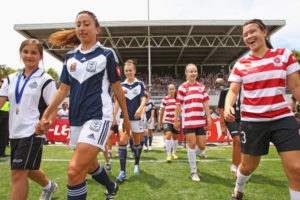Former Australian Matildas midfielder Tal Karp has declared the best method to forward gender equality in sport is Football despite the struggles the W-League has faced with the quick rise of AFL Women’s league and Big Bash Women’s Cricket League.
Speaking with ABC Grandstand, Karp believes the W-League, the Australian premier national league for women, has made great achievements in the 9 seasons since emerging.
Women’s football has been a challenge for the FFA coming from a national history of a male dominated ethnic sport, in nine seasons however it is clear the athletically talented Women have provided a base example for other codes as we can see with AFLW.
It remains one of the most popular sports in the youth development spectrum but like other leagues, it needs to take note of opportunities to grow elsewhere and make available for women to be playing the game by implementing different facilities (like more football academies) and a goal to ensure players are compensated for their efforts more fairly.
David Gallop, head honcho of the FFA, said at the Female Football Week launch that it’s important women’s football is kept in sight with an ambition to improve the status.

Crowds have risen steadily since the first season. Image Credit: FFA.
The positives were also focused on. Crowds at W-League and Matilda games have risen – the Wanderers just released a statement on the average home game breaking the 1000 barrier – while the 2017 W-League grand final was the most watched exhibition in its 9 season history topping out at 440K viewers across coverage on the public owned ABC and Foxtel pay-tv audiences.
While this, along with the fact that the league is attracting great talent from domestic and international level clubs, is something to be proud of – there is still a gap to fill. According to the Football Federation Australia National Audit in 2015, 100,000+ women currently play football in Australia, making up just under 25% of the FFA’s national participation rate.

The 1999 Matilda’s posed for a fundraising calendar to acquire equipment. Previous to this they used second-hand Socceroos property. Amy Duggan pictured.
Ask me and I will tell you a major step forward will be to improve the exposure of the sport. Currently a single match of the W-League is shown per week during the season. At the very least, all matches should be broadcasted – even if they aren’t shown live. How is a fan expected to follow their team if it’s luck of the draw if that one match will be your team? Sure you can go to home games (and you should because that atmosphere is incomparable) but what happens to the Wellington fans when their team takes on Perth and theres no broadcasts?
The clubs social media outlets and local radio have tried to fill the gap, but if anyone wants to make the claim that their network is the “undisputed home of the W-League” surely they should make all matches available in some form.
At this time we can hope that the FFA sticks by its word and improves the environment to ensure the W-League realises its full potential, in the meantime its up to you and I to get out there and support our local club and national superstars.
[alert variation=”alert-info”]FNX honours and celebrates the worlds great female achievers during this our annual FNX Women’s Week of 2017. We acknowledge the accomplishments of women across the world and hope we can be a positive influence and power to ensure gender equality is realised. [/alert]
Banner Image Source: Matildas, Football Federation Australia.






